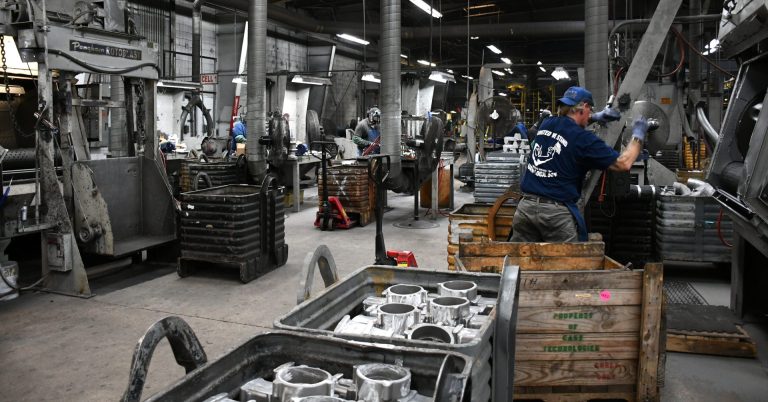Elevate Your Assembly Line: Aluminum Casting Approaches That Supply Outcomes
Wiki Article
Dive Into the World of Light Weight Aluminum Spreading: Comprehending the Various Techniques
Light weight aluminum spreading is an essential process in the manufacturing sector, with different approaches used to produce specific and complex elements. Understanding the various methods utilized in aluminum spreading can supply important understandings into the capacities and constraints of each technique. From the conventional sand spreading method to the innovative die casting procedure, each technique offers special advantages depending on the needs of the job. Discovering these diverse approaches can use a comprehensive sight of the possibilities within the globe of aluminum spreading and how each technique adds to shaping the modern-day manufacturing landscape.Sand Casting Approach
Sand spreading, a widely-used approach in aluminum casting procedures, includes producing mold and mildews made from compressed sand for putting liquified steel. This approach is cost-effective and extremely versatile, making it a preferred option for numerous sectors. The process begins with the creation of a pattern, usually made from wood or metal, which is after that pressed into the sand to leave an impact. The sand mixture, typically silica sand mixed with a binder like clay, is snugly loaded around the pattern to form a mold cavity. Once the mold is all set, it is safely placed in a flask and molten aluminum is poured right into the cavity.After the metal has actually cooled and solidified, the sand mold is escaped to reveal the light weight aluminum spreading. Sand casting permits the production of complex shapes and huge parts that might be tough or pricey to produce using various other approaches. It is also a lasting technique as the sand can be reused and utilized numerous times, lowering waste in the spreading process.
Long-term Mold And Mildew Method

One considerable advantage of the Long-term Mold Strategy is the improved dimensional precision it provides. The metal mold and mildew permits tighter tolerances and finer details in the final light weight aluminum castings contrasted to sand spreading approaches. This accuracy makes it a preferred option for applications where tight dimensional control is vital, such as in the aerospace and automobile markets.

Pass Away Casting Refine

Investment Casting Method
Utilizing an accuracy casting technique, Financial investment Casting Approach involves producing complex aluminum elements by pouring liquified steel into a ceramic mold. This process, additionally referred to as lost-wax casting, starts with the development of a wax pattern of the wanted part. this hyperlink This wax pattern is after that covered with a ceramic material to form a covering. When the ceramic shell is hardened, it is heated to eliminate the wax, leaving a hollow ceramic mold.Financial investment casting is commonly utilized for producing parts in industries where complex layouts and tight tolerances are required, such as aerospace, automobile, and clinical tools. The versatility and precision of the Investment Casting Approach make it an important strategy in the world of light weight aluminum spreading.
Lost Foam Casting Technique
Having checked out the complex precision of Investment Casting Approach, the focus now moves to the ingenious technique of Lost Foam Casting in light weight aluminum part production. Lost Foam Spreading, additionally understood as evaporative pattern casting, is a modern technique where a foam pattern of the wanted component is produced and after that coated important link with a refractory product.Furthermore, Lost Foam Casting is a cost-effective procedure as it minimizes the need for cores and permits for the go right here manufacturing of lightweight elements. Despite its advantages, Lost Foam Casting calls for mindful control of the spreading process to ensure and avoid issues high quality elements.
Conclusion
In final thought, light weight aluminum casting offers a range of techniques such as sand spreading, permanent mold and mildew method, pass away spreading, financial investment spreading, and shed foam casting. Each technique has its own benefits and applications, making aluminum casting a versatile and widely used procedure in various industries. Comprehending the differences in between these methods is important in selecting the most ideal casting technique for details manufacturing requirements.Sand casting, a widely-used method in light weight aluminum spreading processes, involves developing molds made of compressed sand for pouring molten metal. aluminum casting.The Long-term Mold Method, like sand spreading, is an additional widespread method utilized in aluminum casting processes, supplying distinctive advantages in terms of mold reusability and dimensional accuracy. The steel mold enables for tighter tolerances and better information in the last aluminum spreadings compared to sand spreading methods. The 2 major types of die casting are chilly chamber pass away spreading and warm chamber die casting, each suitable for various kinds of aluminum alloys.In conclusion, aluminum spreading offers a variety of methods such as sand casting, permanent mold method, die casting, financial investment spreading, and shed foam spreading
Report this wiki page